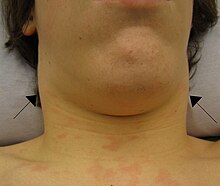| Infectious mononucleosis | |
|---|---|
| Other names | Glandular fever, Pfeiffer's disease, Filatov's disease,[1] kissing disease |
 | |
| Swollen lymph nodes in the neck of a person with infectious mononucleosis | |
| Specialty | Infectious disease |
| Symptoms | Fever, sore throat, enlarged lymph nodes in the neck, fatigue[2] |
| Complications | Swelling of the liver or spleen[3] |
| Duration | 2–4 weeks[2] |
| Causes | Epstein–Barr virus (EBV) usually spread via saliva[2] |
| Diagnostic method | Based on symptoms and blood tests[3] |
| Treatment | Drinking enough fluids, getting sufficient rest, pain medications such as paracetamol (acetaminophen) and ibuprofen[2][4] |
| Frequency | 45 per 100,000 per year (U.S.)[5] |
Infectious mononucleosis (IM, mono), also known as glandular fever, is an infection usually caused by the Epstein–Barr virus (EBV).[2][3] Most people are infected by the virus as children, when the disease produces few or no symptoms.[2] In young adults, the disease often results in fever, sore throat, enlarged lymph nodes in the neck, and fatigue.[2] Most people recover in two to four weeks; however, feeling tired may last for months.[2] The liver or spleen may also become swollen,[3] and in less than one percent of cases splenic rupture may occur.[6]
While usually caused by the Epstein–Barr virus, also known as human herpesvirus 4, which is a member of the herpesvirus family,[3] a few other viruses[3] and the protozoon Toxoplasma gondii[7] may also cause the disease. It is primarily spread through saliva but can rarely be spread through semen or blood.[2] Spread may occur by objects such as drinking glasses or toothbrushes or through a cough or sneeze.[2][8] Those who are infected can spread the disease weeks before symptoms develop.[2] Mono is primarily diagnosed based on the symptoms and can be confirmed with blood tests for specific antibodies.[3] Another typical finding is increased blood lymphocytes of which more than 10% are reactive.[3][9] The monospot test is not recommended for general use due to poor accuracy.[10]
There is no vaccine for EBV; however, there is ongoing research.[11][12] Infection can be prevented by not sharing personal items or saliva with an infected person.[2] Mono generally improves without any specific treatment.[2] Symptoms may be reduced by drinking enough fluids, getting sufficient rest, and taking pain medications such as paracetamol (acetaminophen) and ibuprofen.[2][4]
Mononucleosis most commonly affects those between the ages of 15 and 24 years in the developed world.[9] In the developing world, people are more often infected in early childhood when there are fewer symptoms.[13] In those between 16 and 20 it is the cause of about 8% of sore throats.[9] About 45 out of 100,000 people develop infectious mono each year in the United States.[5] Nearly 95% of people have had an EBV infection by the time they are adults.[5] The disease occurs equally at all times of the year.[9] Mononucleosis was first described in the 1920s and is colloquially known as "the kissing disease".[14]
- ^ Filatov's disease at Who Named It?
- ^ a b c d e f g h i j k l m n "About Epstein-Barr Virus (EBV)". CDC. January 7, 2014. Archived from the original on August 8, 2016. Retrieved Aug 10, 2016.
- ^ a b c d e f g h "About Infectious Mononucleosis". CDC. January 7, 2014. Archived from the original on 8 August 2016. Retrieved 10 August 2016.
- ^ a b Ebell MH (12 April 2016). "JAMA PATIENT PAGE. Infectious Mononucleosis". JAMA. 315 (14): 1532. doi:10.1001/jama.2016.2474. PMID 27115282.
- ^ a b c Tyring S, Moore AY, Lupi O (2016). Mucocutaneous Manifestations of Viral Diseases: An Illustrated Guide to Diagnosis and Management (2 ed.). CRC Press. p. 123. ISBN 978-1-4200-7313-3. Archived from the original on 2017-09-11.
- ^ Handin RI, Lux SE, Stossel TP (2003). Blood: Principles and Practice of Hematology. Lippincott Williams & Wilkins. p. 641. ISBN 978-0-7817-1993-3. Archived from the original on 2017-09-11.
- ^ Cite error: The named reference
jms1978was invoked but never defined (see the help page). - ^ "Mononucleosis - Symptoms and causes". Mayo Clinic. Retrieved 5 February 2020.
- ^ a b c d Ebell MH, Call M, Shinholser J, Gardner J (12 April 2016). "Does This Patient Have Infectious Mononucleosis?: The Rational Clinical Examination Systematic Review". JAMA. 315 (14): 1502–9. doi:10.1001/jama.2016.2111. PMID 27115266.
- ^ "Epstein-Barr Virus and Infectious Mononucleosis Laboratory Testing". CDC. January 7, 2014. Archived from the original on 7 August 2016. Retrieved 10 August 2016.
- ^ "A Study of an Epstein-Barr Virus (EBV) Candidate Vaccine, mRNA-1189, in 12- to 30-Year-Old Healthy Adolescents and Adults". clinicaltrials.gov. 19 November 2023.
- ^ "New Epstein-Barr virus vaccine trial hailed a success so far". MS-UK. 15 August 2023.
- ^ Marx J, Walls R, Hockberger R (2013). Rosen's Emergency Medicine - Concepts and Clinical Practice (8 ed.). Elsevier Health Sciences. p. 1731. ISBN 978-1-4557-4987-4. Archived from the original on 2017-09-11.
- ^ Smart P (1998). Everything You Need to Know about Mononucleosis. The Rosen Publishing Group. p. 11. ISBN 978-0-8239-2550-6.